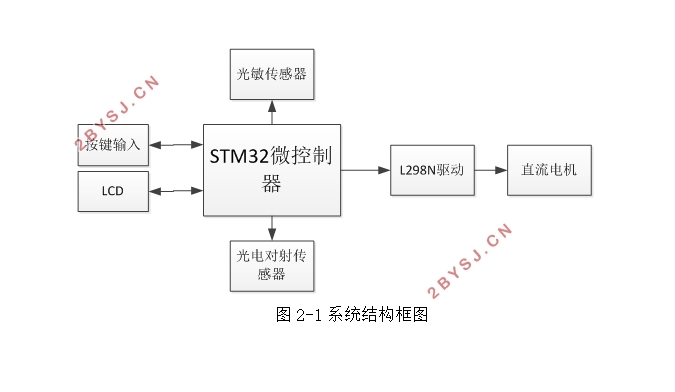基于STM32的智能窗帘的设计
无需注册登录,支付后按照提示操作即可获取该资料.
基于STM32的智能窗帘的设计(选题审批表,任务书,开题报告,开题答辩PPT,外文翻译,周计划表,论文13000字,答辩PPT,答辩记录)
摘 要
在这个经济发展迅速的今天,人们所居住的环境也越来越智能化,这也是社会的必然潮流。目前,家庭居住环境的采光及遮光主要采用的是手动开闭窗帘的方式,这种方式不仅费力而且对于现在快节奏的人们来说,这是拖慢人们生活节奏以及对人们造成了相当一部分的困扰。对于窗帘,它不仅需要美观,更需要其智能化。
本文综述了智能窗帘的设计过程,介绍了所要设计的智能窗帘需要的理论分析和设计思路,以STM32开发板为控制核心,以光敏传感器和光电对射模块为传感器件,以L298N驱动电路和直流电机为执行器件。在设计的过程中对STM32的理论基础知识和外围扩展知识进行了比较全面的准备。硬件采用分块的形式,对整个电路设计进行了分析,系统的整体框图,各模块的电路图等相关电路。利用STM32微控制器上的自带按键实现窗帘定时开关时间以及当前时间的设置。通过本设计可以实现窗帘的光感控制和定时控制。
关键词:STM32 智能窗帘 定时 直流电机
Intelligent Curtain Control Base Of STM32
Abstract
The rapid development of economy in this day.People living environment has become more and more intelligent, This is also the inevitable trend of society. At present, the lighting and shading family living environment is mainly used in the manual opening and closing curtains, this approach is not only laborious but also for people who are now fast-paced, this is slowing down the pace of life of people and the people causing a considerable part of problems. For curtains, it requires not only beautiful, but also need their intelligence.
This article reviews the intelligent curtain design process, introduced to be designed smart curtains require theoretical analysis and design ideas to STM32 development board for the control of the core, light sensors and photoelectric beam module sensors to L298N drive circuit and DC motor for the implementation of the device. In the design process of the theoretical basis for STM32 peripheral expansion of knowledge and knowledge makes a comprehensive preparation. Hardware in the form of sub-blocks of the entire circuit design analysis, an overall block diagram of the system, a circuit diagram of each module and other related circuitry. STM32 microcontroller using its own button on the realization of the curtain time switch time and the current time is set. This design can be achieved through the curtains of light control and timing control.
Key Words :STM32;Intelligent Curtain;Timing;DC Motor


目 录
摘 要 I
ABSTRACT II
第一章 绪 论 1
1.1智能窗帘的简介 1
1.2研究的背景和意义 1
1.3国内外研究及应用现状 2
1.4设计的基本内容 2
第二章 器件选型与总体方案 4
2.1 模块选择 4
2.1.1光传感器模块 4
2.1.2电机驱动模块 5
2.1.3电机 7
2.1.4限位模块 8
2.2系统的基本功能 9
2.3系统总体结构设计 9
第三章 硬件分析与设计 11
3.1 STM32及相关电路 11
3.1.1时钟源的选择 12
3.1.2 电源供给 12
3.1.3显示电路 13
3.1.4按键电路 13
3.2 模块电路 14
3.2.1光敏传感器 14
3.2.2 L298N驱动 15
3.2.3 光电对射传感器 16
3.2.4 电机 17
第四章 程序分析与设计 18
4.1 主程序设计 18
4.2主要子程序设计 19
4.2.1 键盘程序设计 19
4.2.2 定时程序设计 20
4.2.3 直流电机程序设计 22
4.2.4 窗帘控制程序设计 23
4.2.5 主要LCD显示程序设计 25
第五章 总体调试及平台搭建 27
5.1 硬件调试 27
5.2 软件调试 28
5.3 平台搭建 29
结束语 31
参考文献 32
致谢 34
